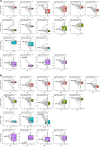Remdesivir postexposure prophylaxis limits measles-induced "immune amnesia" and measles antibody responses in macaques
- PMID: 40306326
- PMCID: PMC12220960
- DOI: 10.1172/jci.insight.190740
Remdesivir postexposure prophylaxis limits measles-induced "immune amnesia" and measles antibody responses in macaques
Abstract
Measles remains one of the most important causes of worldwide morbidity and mortality in children. Measles virus (MeV) replicates extensively in lymphoid tissue, and most deaths are due to other infectious diseases associated with MeV-induced loss of circulating antibodies to other pathogens. To determine whether remdesivir, a broad-spectrum direct-acting antiviral, affects MeV-induced loss of antibody to other pathogens, we expanded the VirScan technology to detect antibodies to both human and macaque pathogens. We measured the antibody reactivity to MeV and non-MeV viral peptides using plasma from MeV-infected macaques that received remdesivir either as postexposure prophylaxis (PEP) (d3-d14) or as late treatment (LT) (d11-d22) in comparison with macaques that were not treated. Remdesivir PEP, but not LT, limited the loss of antibody to non-MeV pathogens. Remdesivir PEP also limited the antibody response to MeV with a decrease in both the magnitude and breadth of the epitopes recognized. LT had little effect on the magnitude of the MeV-specific antibody response but affected the breadth of the response. Therefore, early, but not late, treatment of measles with the direct-acting antiviral remdesivir prevents the loss of antibody to other pathogens but decreases the response to MeV.
Keywords: Adaptive immunity; Immunology; Infectious disease; Virology.
Figures






References
MeSH terms
Substances
Grants and funding
LinkOut - more resources
Full Text Sources
Medical
Miscellaneous

